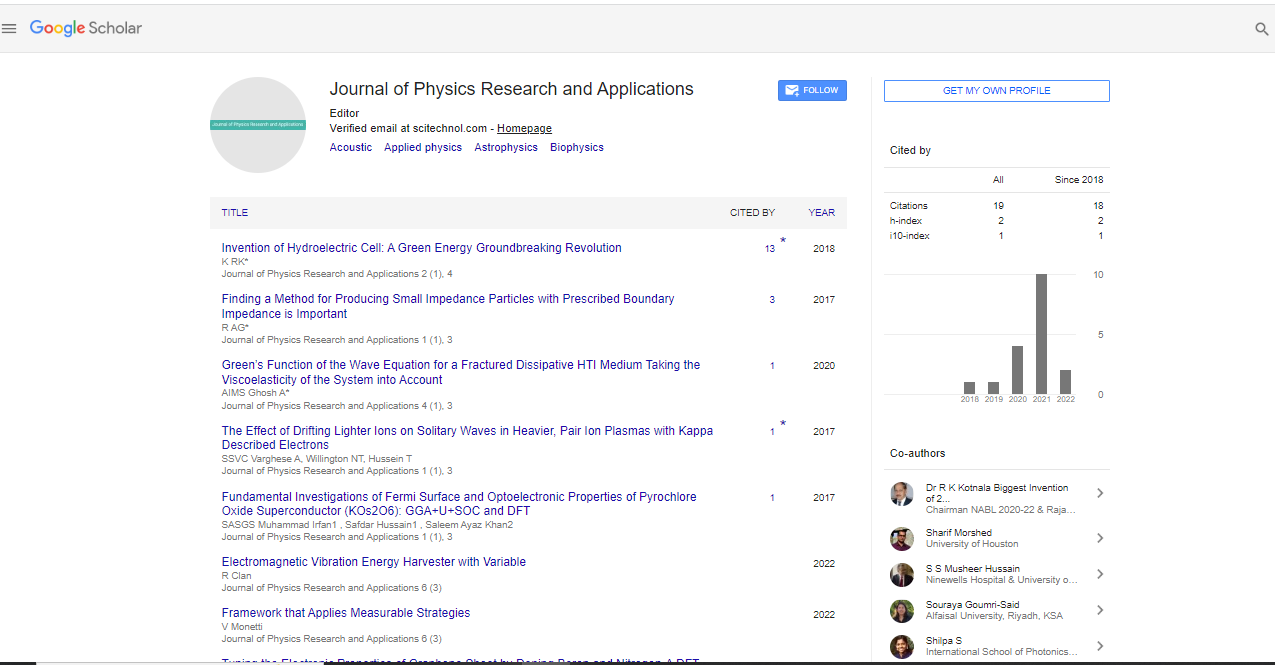Perspective, Vol: 8 Issue: 3
Theoretical Challenges in Explaining Dark Energy within Particle Physics
Arnold Russo*
1Department of Physics, Chung-Ang University, Seoul, South Korea
*Corresponding Author: Arnold Russo,
Department of Physics, Chung-Ang
University, Seoul, South Korea
E-mail: russo@arn.kr
Received: 26 August, 2024, Manuscript No. JPRA-24-151994;
Editor assigned: 28 August, 2024 , PreQC No. JPRA-24-151994 (PQ);
Reviewed: 11 September, 2024, QC No. JPRA-24-151994;
Revised: 18 September, 2024, Manuscript No. JPRA-24-151994 (R);
Published: 25 September, 2024, DOI: 10.4172/JPRA.1000118.
Citation: Russo A (2024) Theoretical Challenges in Explaining Dark Energy within Particle Physics. J Phys Res Appl 8:3.
Description
The discovery that the universe’s expansion is accelerating was one of the most important revelations in cosmology, leading to the concept of dark energy as the driving force behind this acceleration. While dark energy accounts for about 70% of the total energy density of the universe, its nature remains one of the greatest mysteries in modern physics. Despite numerous theories and extensive research, particle physics has yet to provide a fully satisfactory explanation for dark energy, posing unique theoretical challenges in quantum mechanics, relativity and cosmology. The cosmological constant, originally introduced by Einstein as a mathematical adjustment to allow a static universe, was reinterpreted after the discovery of the accelerating universe in the late 20th century. In modern cosmology, the cosmological constant is one of the simplest models for dark energy. It represents a constant energy density that pervades space uniformly, effectively exerting a repulsive force counteracting gravity.
The cosmological constant’s energy density corresponds to vacuum energy, a concept in Quantum Field Theory (QFT) where empty space has an intrinsic energy due to quantum fluctuations. Quantum field theory predicts that virtual particles continuously pop in and out of existence, contributing to vacuum energy. However, the predicted energy density of the quantum vacuum is vastly higher than what is observed. The discrepancy between predicted and observed vacuum energy values raises profound questions about the compatibility of quantum mechanics and general relativity. In quantum mechanics, fluctuations at the smallest scales contribute enormously to vacuum energy. But general relativity suggests that this energy should have an observable impact on the large-scale structure of the universe, manifesting as a cosmological constant.
The cosmological constant appears unnaturally small compared to what quantum field theory would predict. The only explanation for such a low value seems to be fine-tuning, where the universe’s parameters are precisely adjusted. Fine-tuning, however, is generally unsatisfactory in physics, which seeks natural, fundamental explanations. If dark energy were not a constant but rather a field that decays over time, it might help explain the current low-energy density. But since the cosmological constant appears stable over billions of years, no mechanism within particle physics has been identified that would allow for this slow decay in a way that matches observations. In particle physics, there is no comprehensive way to reconcile the predicted vacuum energy (from quantum fields) with the observed cosmological constant. This failure suggests an incomplete understanding of the interaction between quantum fluctuations and spacetime on a cosmological scale.
Given the limitations of the cosmological constant model, theorists have explored the idea that dark energy might be dynamic rather than static. One prominent approach is to model dark energy as a scalar field, a type of field often used in particle physics to represent particles without spin, such as the Higgs field. These scalar field models introduce flexibility into how dark energy might evolve over time, potentially offering solutions to some of the theoretical challenges.
Quintessence is a theoretical model where dark energy is represented by a scalar field that evolves dynamically. Unlike the cosmological constant, quintessence allows the energy density of dark energy to vary over time, depending on the value of the field. This dynamical behavior offers an alternative to the cosmological constant problem, potentially explaining why dark energy has a small value today if it is gradually decaying. However, quintessence models face their own challenges. For one, the quintessence field must be extremely light to evolve slowly enough to match observations. Additionally, the potential energy of the field needs to be finely adjusted to produce the observed acceleration rate. Like the cosmological constant, quintessence does not fully resolve the issue of fine-tuning. Modified gravity theories are theoretically appealing because they aim to integrate dark energy with a broader understanding of gravity. However, they are difficult to test directly, as their predictions often align closely with general relativity at smaller, observable scales.
 Spanish
Spanish  Chinese
Chinese  Russian
Russian  German
German  French
French  Japanese
Japanese  Portuguese
Portuguese  Hindi
Hindi 
